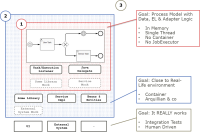Review feedback:
The Java EE example is very hard to understand if you are not a Java EE guy (acronyms galore). I propose to add some more general explanations to the "Scoping Tests" section, so readers can get the general idea without understanding the example.
For example, we could elaborate on scopes and layers and say that the inner-most scope
- mocks the most dependencies
- is farthest away from the real world
- is cheap to set up
- makes it easy to write a multitude of process-focused tests
and that the outer-most scope
- mocks the least or no dependencies
- is closest to real world
- is expensive to set up
- is therefore restricted to integration testing of certain scenarios, not all possible scenarios
Then we can say that for every layer/scope, one needs ways to mock the desired dependencies and ways to test in that scope.
Then give simple examples of what a scope could be (e.g. gateway expression) and how process dependencies can be mocked (e.g. in-memory database).
Then have the Java EE example that shows how one could define the scopes.
Task
L3 - Default

closed for review
https://github.com/camunda/camunda-docs-manual/commit/7f9541f4da9cf305de2c9f8fdbb58d0a88c7f626